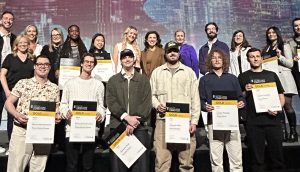Moments after his intro at an Audit Bureau of Circulations event in Toronto yesterday, Carat Americas CEO David Verklin stepped into the crowd and started grilling the assembled with questions.
How many cell phones are there in China? (Answer: 400 million, more the total US population.) When are the most emails opened? (Tuesdays and Thursdays, 11 am to 2 pm) What’s the redemption rate for coupons in newspapers versus those doled out online? (1% for print, 15% for electronic.) E-coupons, he says, are gonna be huge by 2010.
Tying his mobile-minded stats to measurable marketing tools, Verklin launched into a tale about ‘Adrian.’ Adrian gets on the subway, sees a digital OOH video ad for Spiderman 4 with a web link at the end, whips out his mobile to key it in, and instantly gets access to a bunch of exclusive content. Then he gets to the grocery store, hears an announcement about a Spiderman cereal promo and… You get the point. The beauty of mobile, says Verklin, is that nobody yet rules the space. It’s wide open for the taking.
Promoting his new book Watch This, Listen Up, Click Here, Verklin told the ABC crowd that the old way is gone. No more separate silos for the creatives and the media buyers – they’ve got to work together to innovate across platforms.
‘We have the opportunity to create a new model in the advertising business,’ he explained. ‘This is the concept of the powered buy – a creative agency powered by a media services partner. I don’t believe we should return to the old way. The new way is Leo Burnett powered by Starcom, Chiat/Day powered by OMD, the Mariott powered by McGarryBowen and Carat.
‘The original role of the media department was to simply truck the message to the appropriate outlet,’ Verklin continued. ‘We were a conduit to the customer. Our job in media was done once the ad was printed or aired. We bought time and space, delivered the ad, and then repeated the process with other clients. The powered buy is a metaphor for what I see as the new media services role in a new content and media collaboration in the agency process.
‘The media planning process has evolved because there are simply too many TV stations, too many websites, too many radio stations, too many publications, and too many mobile phones. A single creative idea can not possibly fit into all of those channels successfully.’
Verklin was quick to point out several companies and marketing signs to watch for over the next nine months. Pay attention to the gaming industry, he said. In November 2004, Halo was released for Microsoft Xbox. Three weeks before its release, more than 1.5 million copies had been ordered. On its first day, it sold 2.38 million copies worldwide – totalling more than $125 million in sales, and exceeding Hollywood’s best opening weekend in history.
Halo 2 sold more than seven million copies. Later this year, Halo 3 is coming in three different editions. Pre-sales began in late March, and it’s already one of the 10 best-selling games for Xbox – and it hasn’t even been released yet.
And then there’s the iPhone, which will be the product that bridges the gap between online and mobile content consumption, in Verklin’s opinion. And (even if it scares you), watch TiVo and Joost.com – because they’re on the leading edge of connecting the web and TV as content platforms. Watch Veoh.com, because it’s an online indie collaborative that’s designed to learn about consumers by what they’re watching. And – just for fun – log on to Gather.com, the MySpace for grown-ups.
In closing, Verklin told the ABC crowd that the golden age of persuasion has arrived, and he borrowed the term ‘database of intentions’ from tech writer John Battelle. ‘The database of intentions is simply this: the aggregate result of every search ever entered, every result list ever tendered, every path ever taken online as a result.
‘It lives in many places, but three or four of them hold the database of intentions, and a massive amount of this data – MSN, Google, Yahoo! and AOL,’ he added. ‘We have a history of every click, every action taken on the web from the time the web began. This information represents a placeholder for the intentions of humankind, a massive database of desires, wants, needs, and likes that can be discovered, subpoena’d, archived, tracked and exploited for all kinds of ends. Such a beast has never existed before in the history of our culture.’
So, put it to use, Verklin advised. Does a brand build its own Google, its own database of intentions? Carat created a database of intentions for Coca Cola in China called iCoke – an online portal with mobile tie-ins that allows consumers to engage with the brand. You buy a Coke, pull off the bottle top, key in a secret code at iCoke’s website and you get merchandise, downloads for your phone and different Coke experiences. As of today, he noted, iCoke has more than 32 million registered users – 25% of the Chinese internet population.
‘Can you imagine the data that affords Coke? Coke will literally know what its customers want before they do,’ Verklin concluded. ‘Based on the customers’ interaction on the site, Coke will have all or most of the market research they need.’


















